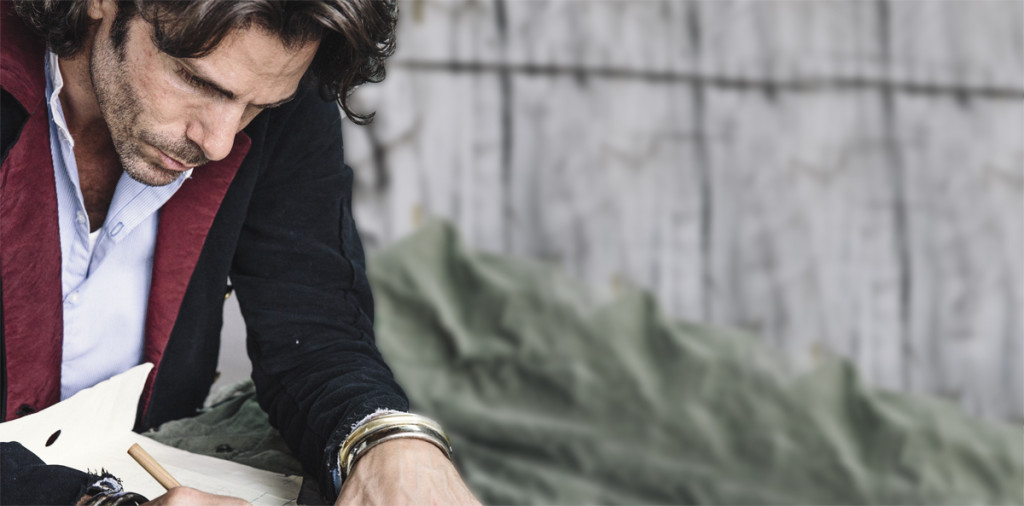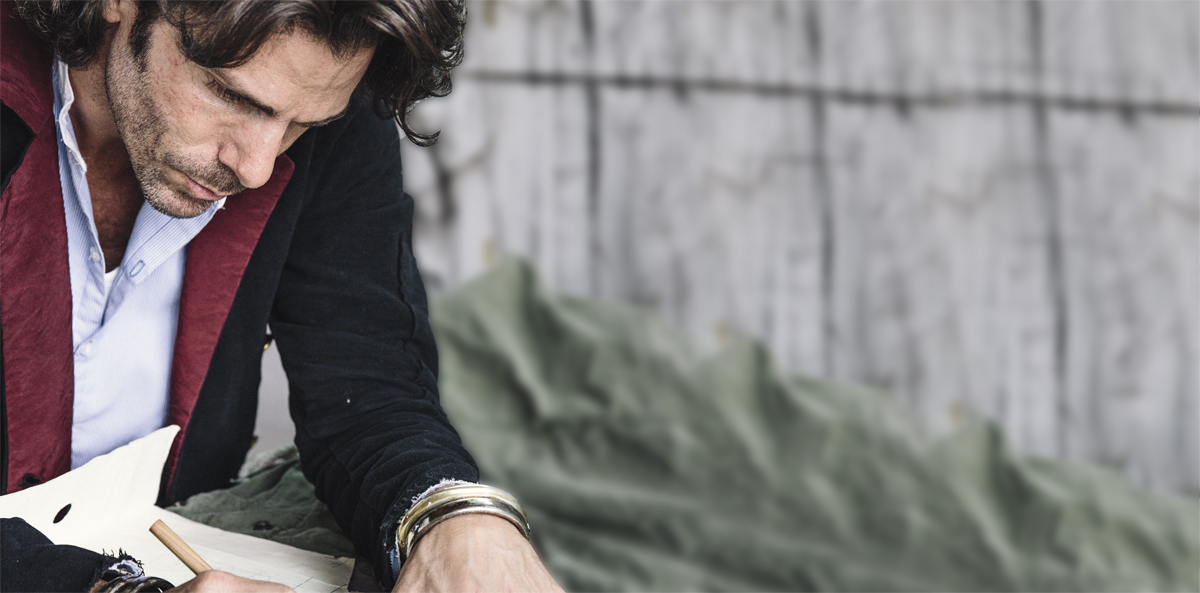On NYFWM: Greg Lauren


My journey is a very interesting one. I launched my collection, which is both men’s and women’s, four and a half years ago in spring of 2011. It was born out of a multiple art exhibition experience that I had had the year before that. And in that exhibition, which was kind of the turning point for me, I had learned to sew so that I could explore my relationship to clothing, specifically exploring the idea of the male archetype as I had been exposed to it which was through a very unique experience of growing up through the lens of style and image being spoon fed to me at a very young age. Certainly as one could imagine, being from my family, I was exposed to things at a very young age, and one of those things was the beauty of menswear, the kind of icons that I was taught to fall in love with, and the kind of icon I should inspire to dress like and be like through the clothing that I wore. So when I had this art exhibition, I made roughly 40 or 50 of the most iconic menswear pieces out of paper. It was my way of exploring that and celebrating as well as saying goodbye to some of these things based on heroes that I had inherited, and my own voice as a designer came through and I started making the wearable pieces that always embody an artistic approach and a contradiction of ideas and images. The one that I got the most recognition for was my first 3 piece suit, which I made out of a destroyed repurposed military duffle bag. That was really the beginning for me because it allowed me to look at the different kinds of things that we are trying to figure out through what we wear, and that was the beginning of my foray into wearable clothing. Now it’s a full collection of jackets and shirts and coats and pants, and there is always the DNA of this artistic handmade approach, whether the pieces are truly one of a kind, or look one of a kind, they are all made one at a time in my studio in Los Angeles. The key to my collection is that nothing is factory made. I use a lot of repurposed fabrics, but nothing is reworked; if I use old fabrics they’re completely recut to my own original silhouettes. There is always an emphasis on the utmost respect for tailoring and the heritage of making clothes. I just love redirecting it through my artistic vision and if that means something is made from something completely destroyed, that excites me.
What has the reception been like?
It’s been incredible. We’re now in almost 50 stores around the world. Somewhere like Barneys, which is such an amazing place for that range of clothing, where there is something for anyone who is style conscious and looking for something new. But of course the niche stores are where I can really show the scope of what I do, where there’s a built-in customer base that is looking for that aesthetic. There is no convincing anybody when it’s at a store like Dover Street or many stores in Japan and China. It’s exciting, the response has really grown so now I have found a loyal fan base among people who just love different kinds of clothing, and many musicians and actors and athletes are starting to really appreciate it. The message that I keep getting is that individuality and uniqueness, at least to me, is the new definition of luxury, so that a piece that is special, where you can feel the fingerprints of someone having made this, is more valuable than the most expensive factory-made cashmere coat.
You’re part of one the biggest families in American fashion, using repurposed American fabrics for your American brand, but would you say that you are influenced by some of the major Japanese designers, like Rei Kawakubo and Yohji Yamamoto?
I think what happens is, because of my DNA of having learned about these classic archetypes, or the classic suit, I was taught that you could feel like and be like any of these things whether or not you actually live that life. There’s as much influence from a classic denim work jacket in my stuff as there is from a beautiful Savile Row suit or a vintage heavyweight 100% cotton hoody. I remember the day I went to LL Bean as a child and got my first red and black buffalo check wool shirt. These are all things that I grew up appreciating in their own right; each one has had some ingredient in my life. What I have been told by Dover Street, which is what I appreciate, is that they actually like my collection because the spirit is the same as everything that they carry, but it is the only thing like itself in the store, and they appreciate that. I try to look at everything I do and I never try to make something like someone else’s. I am always trying to explore what men want to wear, what they think they’re allowed to wear, who they think they should be, and most importantly, what I am trying to express is who we want to be, as men. I think Rick Owens is the most important designer of the last 25 years, because I think he is the latest official addition to the cannon of menswear designers, because since him, we haven’t seen an actual newly invented style enter the pantheon of style to be imitated by all. So I love trying to take my roots from things that have a heritage, and then really challenge myself as an artist to redefine this and change the conversation of what a jacket should be, whether it be how I make it, what fabric I’m using, the shape of it, instead of projecting an image or a stereotype.
Having the NYFW: Men’s schedule realigned with the men’s buying calendar will get the collections in front of more buyers in advance of placing orders. Do you think that will shift business radically?
I think the most important thing about this fashion week is not about the business itself. We can agree that it’s helping the timing of buyers, but I think the real value of this fashion week is that it signifies a zeitgeist: menswear as equally as worthy as women’s. There is this surge of creativity and a sense of as much innovation in menswear and there is in womenswear. I think the importance of this fashion week is more about solidifying menswear as a place where exciting things are happening artistically and creatively. I know that people are saying that it’s about the business, but I really believe there is a very special kind of renaissance of ideas happening in menswear at the moment. It’s really that there are exciting, fresh ideas happening in many places for the first time. For a while there were these classic heritage brands, and there were the truly avant-garde brands, and I think that somewhere in-between those two is a really exciting place to be. There are a lot of exciting things happening that are extremely wearable and extremely desirable that men will covet, that don’t fall under either of those categories, and that is what’s going to be showcased during this NYMFW. It would be boring if it was just about helping out the buying schedule. I think the reason why menswear is having such a moment, is because of the ideas that are coming out and because of the changing attitudes of men towards fashion. American menswear is no longer playing second fiddle to womenswear or to men’s fashion weeks that exist in the other countries. It’s such an honor to be included in the NYFWM’s schedule, which is showcasing what is happening here and I really see it as being one voice of a collective. If it goes the way we all hope it does, it should be like an amazing orchestra playing an incredible symphony, where all of these unique voices and instruments are part of a larger thing, that’s also why I was excited to show at the venue itself, because its important and exciting to be part of the group, part of this orchestra. There are a lot of different and unique things happening. I am based in LA, and I look at NYFWM as very similar to how people are looking at LA: it’s the most creative place on the planet right now, its where the most exciting hybrid of ideas are happening, and its not that there is a singular movement, its that there is a spirit happening in LA, in the same way that there is a spirit happening in menswear. People are excited to do things in a new way, and out here, it’s always been embraced. There are no rules anyone has to abide by. I applaud the CFDA for recognizing that this is happening in menswear, because if this had happened even two or three years ago, it wouldn’t have been as exciting, it would have just been about the buying. The way I see it, is that it’s a benefit of doing it, but it’s not the most important thing that will come from this fashion week. It’s really about looking at what’s happening and looking at the ideas that are being put out there, and that menswear is being embraced as an exciting place to be.








